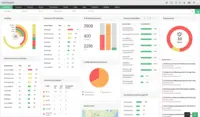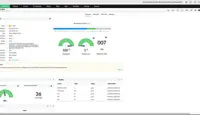Overview
What is ManageEngine OpManager?
ManageEngine's OpManager is network performance monitoring software.
Best product for Network infrastructure
ManageEngine OpManager End User Review
ManageEngine OpManager is the Server Monitoring Tool You've Been Looking For
ManageEngine OpManager: Affordable and Easy to Use
ManageEngine OpManager, A Great Product!
ManageEngine OpManager: Excellent Monitoring Tool
User-Friendly Software
Efficient Monitoring Quick Resolution
Best Tool for Monitoring IT Infrastructure
OpManager to the rescue!
Review on OPManager
OpManager has earned a space in our data center
ME OpManager Reviewed by CBD user
Good affordable monitoring tool businesse
Awards
Products that are considered exceptional by their customers based on a variety of criteria win TrustRadius awards. Learn more about the types of TrustRadius awards to make the best purchase decision. More about TrustRadius Awards
Popular Features
- Alerts (36)9.595%
- Hardware health monitoring (36)9.292%
- Automated network device discovery (35)8.787%
- Customizable reports (34)8.383%
Reviewer Pros & Cons
Pricing
Standard Edition
$245
Professional Edition
$345
Enterprise Edition
11,545
Entry-level set up fee?
- $245 per installationOptional
Offerings
- Free Trial
- Free/Freemium Version
- Premium Consulting/Integration Services
Features
Network Performance Monitoring
A network performance monitoring system monitors the entire network for performance problems and collects performance data such as network traffic analysis performance bottlenecks, etc.
- 8.7Automated network device discovery(35) Ratings
Automated network device discovery allows all devices in the environment to be found and tracked
- 9.1Network monitoring(33) Ratings
Monitoring network device availability and performance indicators like bandwidth, packet loss, CPU, WAN links, etc.
- 8.9Baseline threshold calculation(32) Ratings
Calculation of baseline thresholds so to establish warning thresholds
- 9.5Alerts(36) Ratings
Alerts warning of critical infrastructure component failure can be sent via email or SMS or other channel
- 8.9Network capacity planning(26) Ratings
Capacity planning analyzes interface utilization, disk usage, etc. and allows identification of capacity problems well in advance of threshold breach
- 8.3Packet capture analysis(21) Ratings
Interception of data packets provides performance-related information such as network and application response times, and traffic type analysis
- 7.9Network mapping(26) Ratings
Dynamic mapping tool allows the network topology to be mapped showing performance metrics, and link connection and utilization
- 8.3Customizable reports(34) Ratings
Ability to schedule, generate, and deliver custom performance and availability reports
- 8.4Wireless infrastructure monitoring(24) Ratings
Ability to monitor wireless access points, controllers, and connected clients
- 9.2Hardware health monitoring(36) Ratings
Ability to monitor key hardware metrics including temperature, fan speed, and power supply
Product Details
- About
- Integrations
- Competitors
- Tech Details
- FAQs
What is ManageEngine OpManager?
ManageEngine OpManager is a network monitoring and management tool. It provides real-time network visibility into performance, traffic, and errors across routers, switches, firewalls, physical and virtual servers, and VMs. ManageEngine claims OpManager is a fully integrated monitoring and management platform, with the standard functionality that comes with such an integration:
Monitoring metrics, including packet loss, latency, errors, and performance bottlenecks
Multi-level customizable thresholds for alerts based on monitoring metrics
Customizable dashboards and add-on capabilities
Plans include:
Code-free workflow automation
Distributed network monitoring
Virtualization monitoring for Hyper-V, Citrix Xen, and VMware.
ManageEngine OpManager Features
Network Performance Monitoring Features
- Supported: Automated network device discovery
- Supported: Network monitoring
- Supported: Baseline threshold calculation
- Supported: Alerts
- Supported: Network capacity planning
- Supported: Packet capture analysis
- Supported: Network mapping
- Supported: Customizable reports
- Supported: Wireless infrastructure monitoring
- Supported: Hardware health monitoring
ManageEngine OpManager Screenshots
ManageEngine OpManager Videos
Watch Training and how-to videos of ManageEngine's IT Operations Management tools
ManageEngine OpManager Integrations
- ManageEngine ServiceDesk Plus
- Slack
- ServiceNow IT Service Management
- ManageEngine AlarmsOne
- ManageEngine Applications Manager
ManageEngine OpManager Competitors
ManageEngine OpManager Technical Details
| Deployment Types | On-premise |
|---|---|
| Operating Systems | Windows, Linux |
| Mobile Application | Apple iOS, Android |
| Supported Countries | Latin America, Australia (English) Brazil (Português) China (中文) Denmark (norsk) Deutschland (German) Europe (English) France (French) Greek (English) India (English) Israel (עברית) Italy (italiano) Japan (日Korea, Mexico, Netherlands, Poland, Schweiz, South Africa, Spain, Sverige, Taiwan, Turkey, United Kingdom |
| Supported Languages | French, Japanese, Chinese (simplified), German, Korean, Spanish, Italian, Chinese (Taiwan), Russian |
Frequently Asked Questions
Comparisons
Compare with
Reviews and Ratings
(82)Attribute Ratings
Reviews
(1-25 of 36)- ISP Link monitoring
- L2 & L3 Diagram
- Centralized Configuration of all OEM devices via NCM
- Highly scalable
- A firewall can also monitor
- Servers can also be a part of motioning via ManageEngine OpManager
- L2 & L3 Diagram can be improved for a better view
- Neighbor Devices discover for ease of network view
- More Features in URL Monitoring
- Cloud features can be more detailed
Best product for Network infrastructure
- Easy to use UI
- Low Cost of implementation
- OpManager offers complete visibility across Network
- Needs physical infrastructure to install the application which can be simplified using cloud.
ManageEngine OpManager End User Review
- User-friendly dashboard
- Easy to set up and upgrade
- Fast, responsive support
- Sometimes, adding a server with the same credentials is a little bit tricky
- Version updates must be done manually
- Datacenter 3d viewer needs a more customized angle
- We changed our RDP port to a non-standard port and monitor servers by that instead of a simple ping. Systems that are busted will still respond to pings.
- The dashboard shows us any drives that are almost full. We check this when we do our monthly maintenance.
- Monitoring Windows services and event log events and sending notifications when things don't behave as expected.
- I genuinely don't have any negative feedback for the product.
- I've used many competitor products and this one is my favorite.
ManageEngine OpManager: Affordable and Easy to Use
- Alerting/Notifying
- Customization of Alerts
- Clean UI
- Threshold inactivity disabling monitors with no notification
- The search bar sometimes breaks and doesn't show results properly
- I'd like notifications when new builds are released
ManageEngine OpManager, A Great Product!
- Resources monitoring
- A clear view of the devices being monitored
- Easy and clean graphical user interface
- Wide variety of reporting options
- Alert Mechanism
- Adding devices to existing groups and applying a group-wide parameter.
- Email alerts can be a bit challenging depending on how email is managed within a company, sometimes adding ManageEngine OpManager to the allowed relay list for Exchange is necessary to receive any alerts
ManageEngine OpManager: Excellent Monitoring Tool
- Proactive monitoring
- Alerts notification
- Resource utilization
- Cost saving
- Customization of services
- Kerberos is not supported
User-Friendly Software
- High visibility of the devices
- Text message alerting integration
- SSO capability
- Monitoring services
- US-based support would be appreciated
- I don't like the fact that is Java-based due to security concerns
- Tedious service-pack upgrades
- Out-dated device templates
The performance monitoring is also a useful feature.
Efficient Monitoring Quick Resolution
- Easily integrate with existing solutions
- Self learning of application behavior and adjust monitoring parameters
- Integration with specific third-party applications and systems may be limited
- Reporting and data analysis capabilities may be less robust and required by some businesses
- Customization options may be limited and not easily customizable to meet specific business requirements
Best Tool for Monitoring IT Infrastructure
- Tracking of key metrics like CPU, memory, disk space, network traffic, and application performance in a simple dashboard
- Monitoring of critical business applications like a SMTP mail server, XAMPP web servers, MSSQL databases,
- Real-time alerts for issues like outages, slowdowns based on the threshold value
- It's also helping us to do the capacity planning for future growth.
- Reporting options can still to be improved. i felt limited reporting customization.
- 1st time installation is bit complicated
- Remote office system monitoring is requiring opening firewall port and sometimes it says all the servers are down when the connectivity to the report network is goes offline.
OpManager to the rescue!
- Dashboard that we can provide for the entire team.
- Real time alerts.
- Small footprint
- Range of products it supports
- Integration with other products from ManageEngine. e.g. Application manager - there is no seamless login. Downtime scheduling needs to be done on both products.
- Vmware - There is option to monitor only physical CPUs. e.g. each node of our VMware host has 2 CPUs, which has 24 virtual CPUs. When we get high CPU alert we get 24 alerts for the same issue.
- Banner ads - on the login screen & the product itself. Granted they're about ManageEngine but i would like the option to turn them off permanently.
Review on OPManager
- Uptime Monitoring
- Performance monitoring
- Single pane of glass to monitor entire Infrastructure
- OPManager in Cloud Edition
- Event co relation
- RCA
OpManager has earned a space in our data center
- Alerting when critical systems are down
- Easy to read reporting for all levels of employees
- Capacity planning for virtual servers
- Capacity planning for WAN
- The upgrade process is a little cumbersome, but overall not bad.
- More live training opportunities to network with other OpManager users.
- More device profile integrations
ME OpManager Reviewed by CBD user
- It measures the CPU utilization of hosts, the network bandwidth utilization of links, and other aspects of the operation
- It often sends messages—sometimes called watchdog messages—over the network to each host to verify if it is responsive to requests.
- Set Up Notifications And Reports.
- OpManager offers a set of advantages that allow it to adapt to the needs of the company, guaranteeing effective monitoring of the application networks used in our organization.
- It measures the CPU utilization of hosts, the network bandwidth utilization of links, and other aspects of the operation
- It often sends messages—sometimes called watchdog messages—over the network to each host to verify if it is responsive to requests.
- While OpManager keeps tabs on the performance of your network devices, OpUtils add-on complements it well by allowing network admins to detect, diagnose and troubleshoot network issues, faster.
Good affordable monitoring tool businesse
- Easy to configure
- Provides detailed monitoring of server and network devices
- Proactive nature of the software
- Creation of customize templet is lengthy
- customer server can be better
- topology based maps are not clear needs improvements in that
The Best Product for the SMB's at this Price Segment
- The Support Team is tremendous, If there is any support needed Technically like to create a custom monitoring for a new product if we provide the required MIB file they can create in a minute
- The Interface in pretty much easy to understand even for a beginner
- The Deployment is not an hassle.
- There are many open source products like Nagios etc, even we have tested out that product the customization in that product will be like hassle.
- This product is a worth buying for this price range, as far as monitoring concern
- Even ManageEngine OpManager has Cloud version we can simply use it as an SaaS product
OP Manager an interesting monitoring option
- infrastructure monitoring
- sending notifications in real time
- event log
- integration with Teams or Whatsapp
- automatic generation of cases
Great Monitoring Tool
- Real time alerts
- Preventative alerts
- Recommendations
- Suggestions about security in the ManageEngine OpManager portal
OPManager
- it allows us to quickly respond to alerts in the infrastructure
- the graphical user interface is very user friendly
- monitor of physical and virtual servers CPU and Memory
- custom monitoring dashboards
- useful GUI
- agentless monitor
- ease of use
A Reliable, Trustworthy, and Cost-Effective Product
- easy creation of custom monitoring dashboards
- reliable monitoring of network devices traffic volumes
- reliable monitoring of physical and virtual servers CPU and Memory Utilization
- continuous monitoring with overall visibility and control
- Easy to deploy and scalable
- Improve compliance & risk/ Asset management
- easy setup of custom monitoring dashboards
- Sometimes it takes time to load because it is a web application
- topology based maps needs improvements
Good affordable solution for smaller businesses.
- IP Management
- Inventory Management
- Network Management
- Network Rack Views
- Default menus include upcharge features that aren't usable
- Alerts are obnoxious at times for things you can't disable (ipv6)
- Daily reminder for feature setups
- Button for other purchasable software that you can't remove.
OpManager - A Good Choice For IT Infrastructure Monitoring
- User-friendly GUI
- Agentless monitoring
- The possibility of integrating products from the ME family
- Zoho support
- Often problems with updating to a newer build
- Problems with some devices being monitored by SNMP
- Performance/sizing requirements
ManageEngine OpManager review
- Device uptime and status is clearly visible in the dashboard
- Notification Profiles allow us to be immediately notified when any monitored devices are in an error state or exceeding thresholds
- Installation, configuration, and deployment of this solution are straightforward and well documented
- Not all discovered devices can have their vendor, device, serial number, etc., details automatically populated during discovery. Manually having to enter the specific details for these devices was a little time-consuming but not really an issue.
- Removal of decommissioned devices can be awkward if not done prior to device decommissioning.
- OTP at login does not always work first time, usually, 2 -3 attempts are needed when logging on to the dashboard with OTP.
ManageEngine OpManager is a well rounded solution that provides excellent functionality at a great price
- Ease of deployment
- Ease of configuration
- Ease of use
- We have not found any negatives with what we utilize the solution for
- Network Traffic details using the Netflow Analyzer
- Granular database information thanks to APM
- Be able to add a wide range of monitors to devices for monitoring
- Improve the reporting module, which allows for a better cross-checking of information
- Greater flexibility when building dashboards
- Improve the scope of the NFA add ons, since it is integrated into the Opmanager and provides fewer options than the one installed independently
- Granular monitoring of applications and network traffic
- Distributed network monitoring
- Great diversity of devices that can be added to Opmanager, allowing the use of a single tool for monitoring different device
In my experience with this program and similar tools, the scope is superior, the benefits and the integration with other tools allow us to attack situations with the shortest downtime possible.









